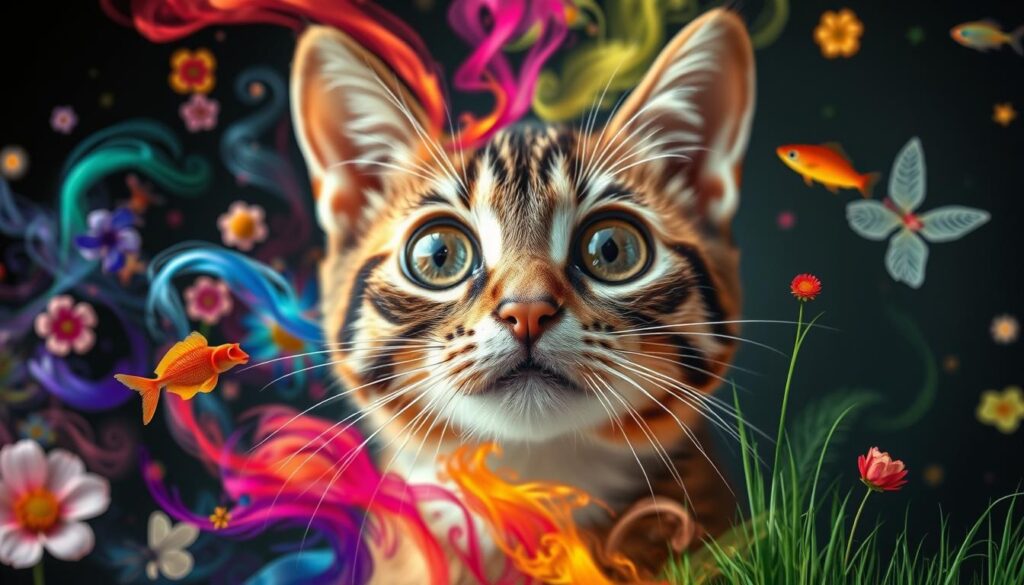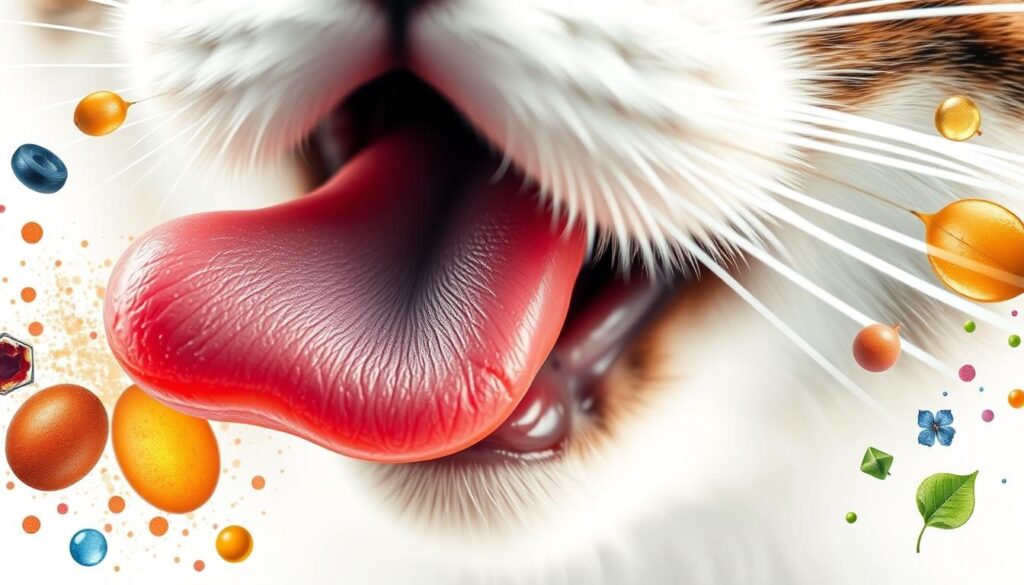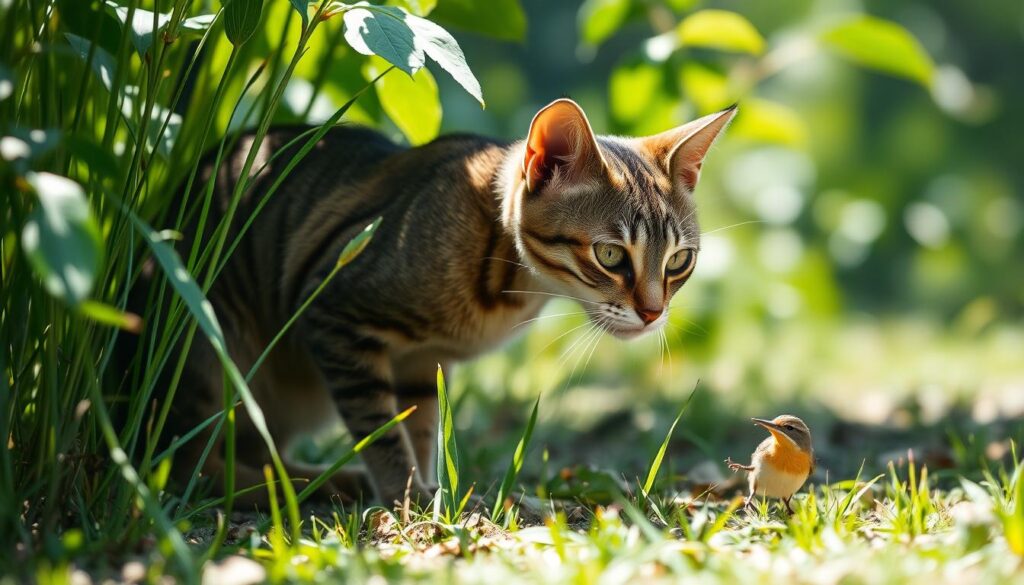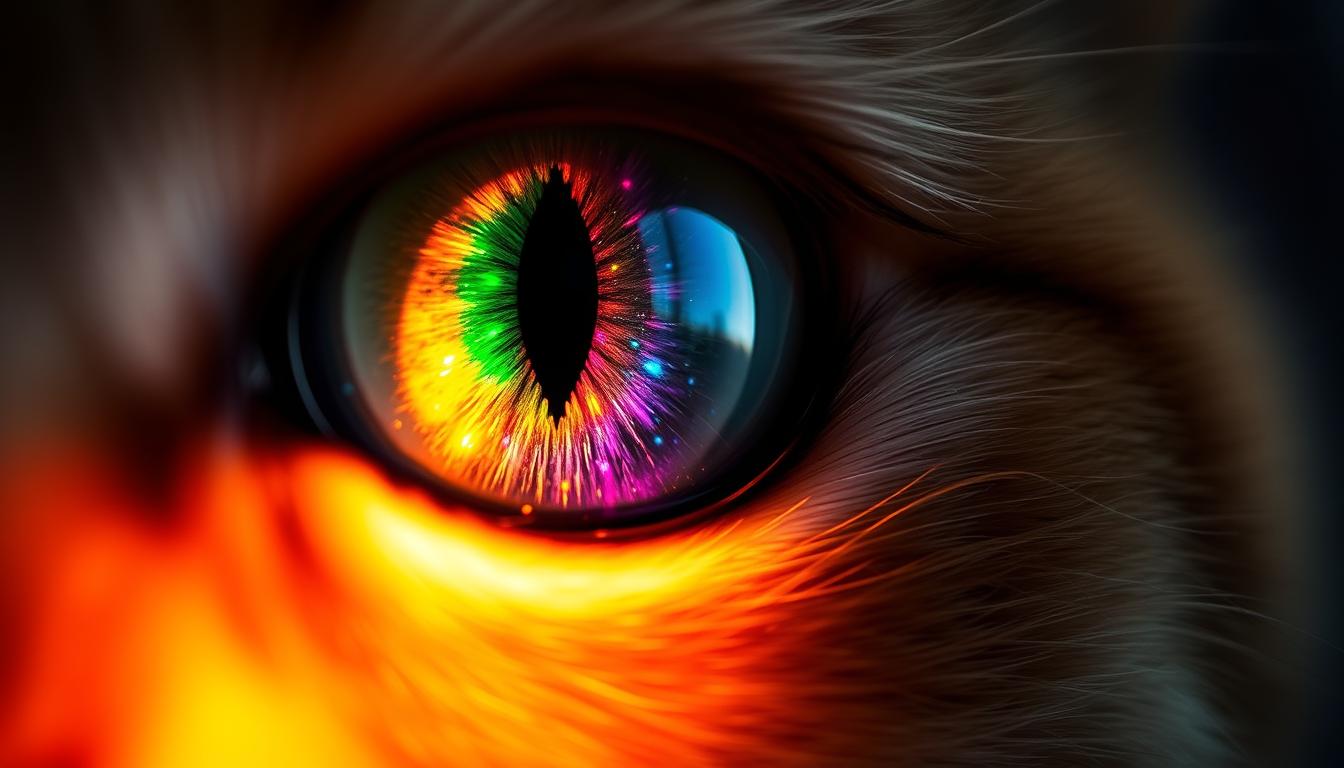Cats experience the world in a way that’s very different from us. Studies show that cats see things in a way that’s not like humans. With over 100 million cats in the U.S., it’s important to understand how they see things. This helps us talk to them better and take care of them right.
Table of Contents
The Unique Anatomy of Cats and Its Impact on Perception
Cats have special parts that make them different from humans. Their vision, whiskers, and hearing are all special. These help them see, feel, and hear better.
How Vision Differs Between Cats and Humans
Cats can see well in the dark. Their eyes have more rods than humans. Rods help them see in the dark but not colors well.
The Role of Whiskers in Sensory Input
Whiskers, or vibrissae, are very important for cats. They are on the cat’s face and body. Whiskers help cats feel their surroundings and find their way.
The Structure of Cat Ears and Hearing Abilities
Cat ears are special too. They can hear sounds that humans can’t. Cats can also turn their ears to listen better.
“Cats possess a remarkable anatomy that sets them apart from their human counterparts, dramatically influencing how they perceive and interact with their surroundings.”
The Sense of Smell: A Key Differentiator
Cats have a super strong sense of smell. It’s way better than ours. Their smell system helps them understand their world, talk to other cats, and find food or danger.
Comparing Olfactory Systems: Cats vs. Humans
Cats have a lot of smell receptors, about 200 million. Humans only have 5 million. This lets cats smell things we can’t. They also have a special organ for smelling pheromones, which are like secret messages for cats.
How Cats Use Smell to Understand Their Environment
Cats use smell to know where they are and what’s around. They mark their territory and talk to other cats with pheromones. They can even tell how other cats feel.
Smell helps them find food and see if there’s danger. It’s a big help for them to survive. They can smell things we can’t, which is really cool.

“Cats have an incredible sense of smell that is up to 14 times more sensitive than humans. This allows them to gather a wealth of information about their environment and communicate in ways that are completely foreign to us.”
The World of Touch: Feline Sensitivity
Cats have a very sharp sense of touch. This helps them feel and understand their world. Their whiskers and paw pads are key to this.
The Importance of Whiskers and Paw Pads
A cat’s whiskers, called vibrissae, are special hairs. They help cats know what’s around them. These hairs can feel even the smallest changes in air.
They also help cats move in the dark and judge how far things are. The nerve endings in their paw pads add to their touch sense. They feel vibrations, temperature, and texture well.
How Cats Utilize Touch for Navigation
Cats use touch a lot to find their way. They feel their surroundings with whiskers and paw pads. This helps them move around, even in the dark or new places.
Knowing how cats feel their world helps us make their lives better. We can make their homes more comfortable and fun. This makes sure they are happy and healthy.
The Role of Taste in Feline Experience
Cats have a special way of tasting things. It’s different from how we taste. Knowing how cats taste is key to feeding them right.
Taste Buds and Preferences in Cats
Cats have fewer taste buds than we do. They have about 470, while we have 9,000. This means cats can’t taste sweet like we do.
They like food that’s high in protein and savory. They love meaty flavors.
How Cats Taste Their Food Differently
Cats can taste certain amino acids better. These are parts of proteins. This shows they’re built to eat meat.
They also smell things better. This helps them taste and choose food.
Knowing about cat taste buds and feline food preferences helps us feed them well. It keeps them healthy and happy.

“Cats have a unique taste experience compared to humans, with fewer taste buds and a heightened sensitivity to protein-rich flavors. This shapes their food preferences and underscores the importance of providing them with the most appropriate and palatable nutrition.”
The Importance of Movement and Body Language
Cats are experts at talking without words. They use their body language to show many feelings and plans. From a tiny ear flick to a big tail swing, their language is full of secrets. Knowing these signs helps us connect better with our cats.
Feline Body Language: Communication Without Words
Cats mostly talk with their bodies, not voices. Watching their ears, tail, and eyes tells us how they feel. They show happiness, calm, or even anger through their body.
How Cats Perceive Movement Around Them
Cats are super good at noticing movement. Their sharp eyes and ears pick up even the smallest things. This skill helps them survive and see the world in a special way.
Learning about cat body language and how they see movement helps us understand them better. This knowledge makes our bond with cats stronger and more loving.
The Cat’s Unique Social Behavior
Cats are known for being independent. But they also have a complex social side. They balance wanting to be alone with needing friends.
Unlike dogs, cats don’t naturally want to be in groups. But they can become very close to their humans and even other cats.
Understanding Feline Independence vs. Social Connection
Cats like to do things on their own. They don’t need to be around people all the time. They can even live alone happily.
But, cats also love to be with their people. They might even want to hang out with other cats too.
The Role of Vocalizations in Cat Communication
Cats talk to us in their own special way. They purr when they’re happy and meow when they need something. Purring shows love, while meowing can mean many things.
Learning about cat social behavior and feline vocalizations helps us understand them better. It makes our bond with them stronger.
Sensory Overload: How Cats Handle Stimulation
Cats are very sensitive. They see and hear things differently than people. Sometimes, they get too much stimulation. It’s important to make their space comfortable and stress-free.
Recognizing Signs of Stress in Cats
Cats show stress in many ways. They might:
- Excessive grooming or licking
- Hiding or retreating to quiet spaces
- Decreased appetite or loss of interest in food
- Increased vocalization, such as meowing or growling
- Changes in sleep patterns or increased lethargy
Creating a Comfortable Environment for Felines
To help cats, we need to make their space nice. This means environmental enrichment and quiet spots. Here are some tips:
- Give them different textures, toys, and hiding spots to explore
- Make sure the home is bright, like their natural habitat
- Keep it quiet and avoid sudden noises
- Provide cozy spots for them to rest
- Play with them in a calm way to build trust
By knowing when cats are stressed and making their space nice, we can help them. This way, they can handle stress better.
| Medication | Indication | Dosage | Considerations |
|---|---|---|---|
| Fluoxetine | Anxiety, OCD | 0.5-2 mg/kg once daily | Needs 6-8 weeks to evaluate effectiveness |
| Clomipramine | Separation anxiety | 2.2-3.3 mg/kg twice daily | Twice daily dosing required |
| Trazodone | Adjunctive therapy | 2.5-10 mg/kg once or twice daily | Low efficacy as sole therapy |
| Alprazolam | Acute anxiety episodes | 0.01-0.05 mg/kg as needed | Commonly used for short-term relief |
| Gabapentin | Stress and anxiety | 5-10 mg/kg once or twice daily | Particularly effective in cats |
Working with a vet is key to finding the right treatment for cat stress. This helps make their space better and more comfortable.
Instinctual Behaviors: Survival vs. Comfort
Cats are amazing, keeping strong hunting instincts even at home. They play like they hunt, which is fun and helps them survive. Knowing about cat hunting instincts helps us understand them better. It also helps us pick the right toys and games for them.
Hunting Instincts and Their Impact on Behavior
Cats need meat to live, showing their hunting nature. Even indoor cats hunt with toys, practicing their skills. We can make their home better by respecting these instincts and giving them fun toys.
Feline Play: A Simulation of Hunting Strategies
Cats sleep a lot, but when they’re up, they play like they hunt. They stalk and pounce on toys, keeping their skills sharp. This play keeps them happy and healthy. Giving them lots of toys and games is good for them.

“Cats are the only mammals that lack taste receptors for sweetness, reflecting their obligate carnivorous nature and the importance of their hunting instincts.”
The Perception of Time in Cats
Cats see time differently than we do. They don’t think in a straight line like we do. Instead, they live by a natural cycle that helps them hunt.
How Cats’ Life Rhythms Differ From Humans
Cats are most active at dawn and dusk. This is when their prey is most active. Humans, on the other hand, stick to a strict schedule and sleep all night.
Feline Sleep Patterns and Their Implications
Cats sleep in short bursts, not long stretches. They can sleep up to 16 hours a day. This helps them stay alert and ready to hunt.
Knowing how cats and humans see time is key to caring for them. By matching their natural rhythms, we can make their lives better. This helps our cat sleep patterns and feline time perception thrive.
“Cats have an internal clock that is quite different from ours. They are attuned to the natural rhythms of the day, not the artificial schedules we’ve created.”
| Characteristic | Humans | Cats |
|---|---|---|
| Activity Cycle | Diurnal (active during the day) | Crepuscular (most active at dawn and dusk) |
| Sleep Patterns | Single, uninterrupted sleep cycle | Multiple short naps throughout the day |
| Time Perception | Linear, clock-driven | Cyclical, instinctual |
Environmental Preferences: Home and Beyond
Cats have special needs that are different from ours. We design homes for ourselves, but we must think about our cats too. This makes our homes better for them.
Ideal Habitats for Cats vs. Humans
Cats love places that meet their cat habitat preferences and feline environmental needs. They like to climb on cat trees and shelves. This lets them see everything around them.
They also like hidden spots where they can feel safe. Humans often prefer open spaces, but cats like cozy, quiet places.
- Vertical territory for climbing and perching
- Hiding spots and cozy retreats
- Scratching posts and surfaces to maintain claw health
- Quiet, low-traffic areas for rest and relaxation
How Cats Experience New vs. Familiar Spaces
Cats are careful in new places. They use their sense of smell to feel safe. By scratching and rubbing, they make new places feel like home.
Places they know well make them feel secure. This lets them be themselves, whether playing or sleeping. Knowing this helps us make our homes better for them.

“The secret of being a good cat owner is understanding the feline mind and respecting their unique needs.”
Conclusion: Celebrating the Feline Perspective
Understanding how cats see the world helps us respect them more. We learn about their senses, behaviors, and likes. This way, we can make their lives better and strengthen our bond with them.
Understanding and Respecting Our Cats’ Experiences
Cats have a special way of seeing the world. They smell and hear better than us. They also talk and act in their own special ways.
By seeing things from their point of view, we can care for them better. This makes our lives together happier and healthier.
The Importance of Feline-Centric Care
It’s important to care for cats in ways that fit their needs. This means making their world interesting and safe. It also means respecting their own special ways.
By focusing on what cats need, we can live together in a way that’s good for both of us. This celebrates the beauty and uniqueness of our feline friends.


1 thought on “How Cats Experience the World Differently from Humans”
Comments are closed.